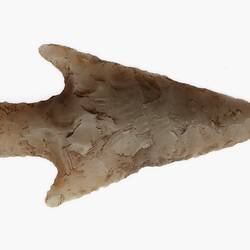Irish Archaeology and William James Knowles and William Spotswood Knowles
Significance
Irish Archaeology and William James Knowles and William Spotswood KnowlesWilliam James Knowles (1832-1927) was a renowned Irish antiquarian who amassed a vast collection of stone tools from north-eastern Ireland. Knowles senior was a member of the Royal Irish Academy, Royal Society of Antiquaries of Ireland and the Royal Anthropological Institute. His work focused on typologies of Irish tools and he combined vigorous excavation with theory and published more than 70 papers (Lunney, 2009).
Working the landscape of his native County Antrim, Knowles enquired with local farmers near towns such as Ballymena and Clough about possible tools. "I encouraged the farmers and labourers to collect the flakes and broken axes, and each market day in Ballymena specimens, in greater or smaller numbers, were brought to me," he wrote in his 'Stone Axe Factories' paper in 1903. "Farmers are surprised that such poor objects should have any value, and when shown a large axe, they assert that they often put such objects in drains.the finest specimen I have was used as a wedge to fasten one of the stakes in a byre." Elsewhere, he undertook the work with his own hands. Near the peak of Tievebulliagh, "It took my wife and daughter, with myself, several days to remove all the manufactured objects" (Knowles, 'Stone Axe Factories', 1903, pp. 360-362).
In 1899, such finds appeared to have played a role as currency when the antiquarian's son, William Spotswood Knowles, commenced an exchange relationship with the Melbourne Ethnographic Museum (then managed by the Industrial and Technological Museum under the structure of the Board of Trustees of the Public Library, Museums and National Gallery of Victoria). In April of that year, the museum received 27 Irish implements from WS Knowles that ranged from flakes to arrowheads to scrapers to a stone hammer with provenance locations that correspond to the father's published works. In return, the museum gave WS Knowles cultural materials from Australia and Papua New Guinea. These included two glass spearheads from Western Australia (X 1211, X 1219). Glass spear heads - a modern technology - would prove to be a particular interest of the son, as they were for many collectors of the turn of the twentieth century (Harrison, 2006). In 1915, WS Knowles successfully sold 26 glass spear heads to the Museum for 2 pounds 10 shillings (WS Knowles, 1915).
In 1903, four years after the arrival of the Irish stone tools at the museum, WJ Knowles published a paper that demonstrates how antiquarians of the time drew on artefacts from vastly different cultural contexts to form theories about tool manufacture and origin. In his 'Irish flint arrow- and spear-heads', Knowles sought to understand continuities between Palaeolithic and Neolithic implements by drawing on observations of collections from Somalia, England, France and Australia (Knowles, 'Irish flint arrow- and spear-heads',1903: 44-45). When theorising about arrowhead and spearhead manufacture, Knowles noted that "My son has brought me spear-heads, made out of bottle glass and telegraph insulators by modern native Australians, which show chipping quite equal to that on ancient flint arrow-heads" (Knowles, 1903: 48).
Bibliography
Rodney Harrison, 'An artefact of colonial desire? Kimberley points and the technologies of enchantment', Current Anthropology, Vol. 47 (1), 2006: 63-88.
WJ Knowles, 'Irish flint arrow- and spear-heads', The Journal of the Anthropological Institute of Great Britain and Ireland, Vol. 33, Jan-June 1903, pp. 44-56.
WJ Knowles, 'Stone Axe Factories Near Cushendall, County Antrim', The Journal of the Anthropological Institute of Great Britain and Ireland, Vol. 33, Jul-Dec 1903, pp. 360-366.
WS Knowles, Correspondence, 1915, Museums Victoria Archives, OLDERSYSTEM-02790, MV ARCHIVES - NATIONAL MUSEUM OF VICTORIA - Inwards Correspondence - 1900-1931 Kitson, AC to Kosminsky, I.
Linde Lunney, 'William James Knowles', Dictionary of Irish Biography, https://www.dib.ie/biography/knowles-william-james-a4604, originally published 2009, accessed 22 September 2025.
Provenance Ledgers and Registers, First Peoples Department, Museums Victoria.
Report of the Trustees of the Public Library, Museums & National Gallery of Victoria for 1899, Government Printer, Melbourne, 1900, p. 24.
Acknowledgements
With thanks to Professor Mark Moore of the Museum of Stone Tools.
